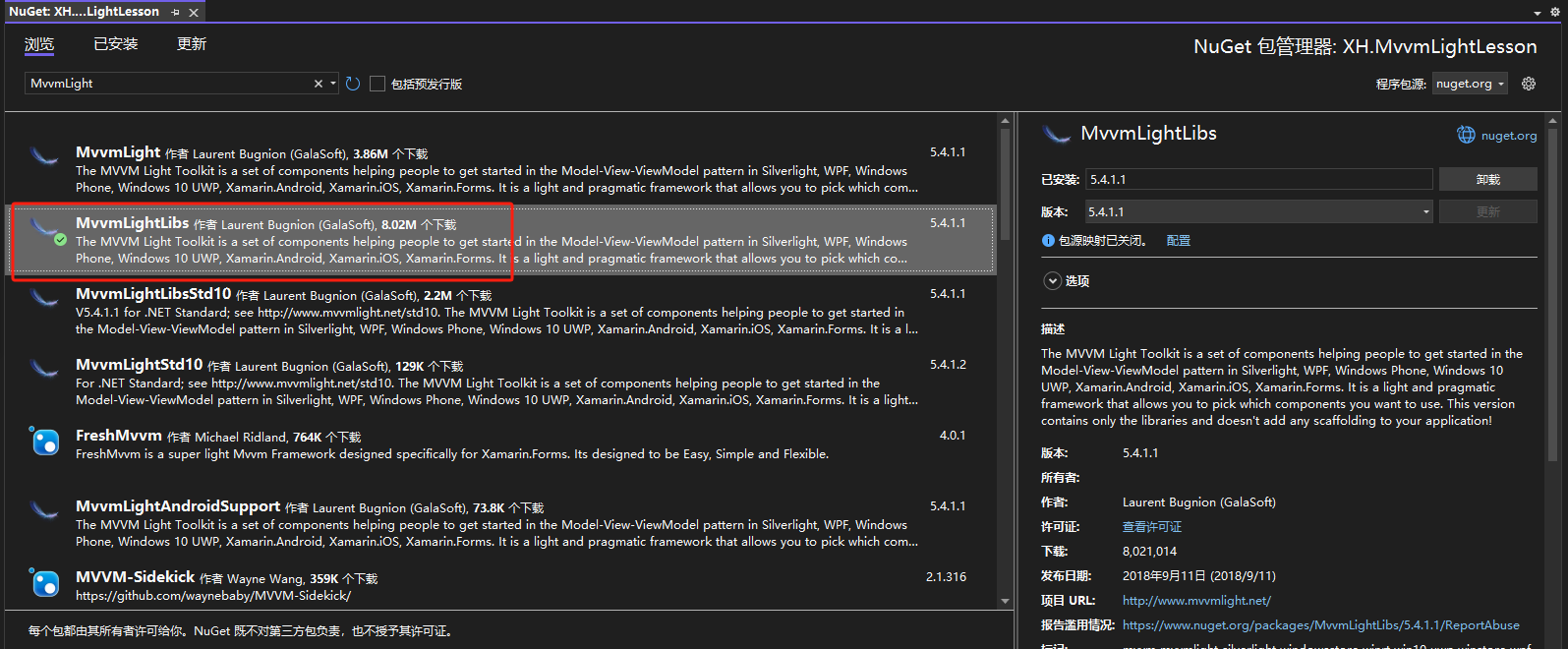关于

停止更新
官网:http://www.mvvmlight.net/
源码地址:GitHub - lbugnion/mvvmlight: The main purpose of the toolkit is to accelerate the creation and development of MVVM applications in Xamarin.Android, Xamarin.iOS, Xamarin.Forms, Windows 10 UWP, Windows Presentation Foundation (WPF), Silverlight, Windows Phone.、https://archive.codeplex.com/?p=mvvmlight(迁移到Github)
开始
通过Nuget平台,引入相关库

框架中的数据与行为
数据绑定与通知:INotifyPropertyChanged
默认:自定义
框架:ObservableObject、ViewModelBase(VM的资源释放)
Model:
public class MainModel : ObservableObject { }ViewModel:
通知方式:RaisePropertyChanged、Set
public class MainViewModel : ViewModelBase
{
private string _value = "Hello";
public string Value
{
get { return _value; }
set
{
// 第一种通知方式
//this.RaisePropertyChanged();
//_value = value;
// 第二种通知方式 建议第二种
Set<string>(ref _value, value);
}
}
// 作用:统一执行对象的资源清理 VM的释放
// View关闭退出的时候 后台线程需要结束
public override void Cleanup()
{
base.Cleanup();
}
}Cleanup:统一执行对象的资源清理 VM的释放
手写MvvmLight中的值通知方法
public class NotifyBase : INotifyPropertyChanged
{
public event PropertyChangedEventHandler? PropertyChanged;
public void SetProperty<T>(ref T propertyName,T value, [CallerMemberName] string propName = "")
{
if (propertyName is null || !propertyName.Equals(value))
{
propertyName = value;
PropertyChanged?.Invoke(this, new PropertyChangedEventArgs(propName));
}
}
}命令绑定对象:ICommand
默认:自定义
框架:RelayCommand、RelayCommand<T>
public RelayCommand BtnCommand { get; set; }
public RelayCommand<object> BtnParamCommand { get; set; }
public MainViewModel()
{
// 第二个参数:按钮是否可以点击按钮状态
BtnCommand = new RelayCommand(DoButtonCommand, DoButtonStatus);
BtnParamCommand = new RelayCommand<object>(DoBtnParamCommand);
}
private void DoButtonCommand()
{
}
private bool DoButtonStatus()
{
return Value == "Hello";
}
private void DoBtnParamCommand(object obj)
{
}设计模式IsInDesignMode
if (this.IsInDesignMode)
{
// 设计时 模拟数据处理
}
else
{
// 运行时执行
}设计模式也可以用xaml写:
<Window x:Class="XH.MvvmLightLesson.Views.MainWindow"
xmlns="http://schemas.microsoft.com/winfx/2006/xaml/presentation"
xmlns:x="http://schemas.microsoft.com/winfx/2006/xaml"
xmlns:d="http://schemas.microsoft.com/expression/blend/2008"
xmlns:mc="http://schemas.openxmlformats.org/markup-compatibility/2006"
xmlns:local="clr-namespace:XH.MvvmLightLesson.Views"
mc:Ignorable="d"
xmlns:vm="clr-namespace:XH.MvvmLightLesson.ViewModels"
Title="MainWindow" Height="450" Width="800">
<!--d:也是设计时的显示,运行不显示-->
<d:Window.DataContext>
<vm:MainViewModel />
</d:Window.DataContext>
</Window>扩展对象
Messenger:
解决对象间的逻辑调用(使得VM可以调用View层面的对象)
注册(委托方法)、发布(主动请求执行这个委托方法)、反注册
注册:在主窗口或者APP.xaml.cs中写方法,主要是View层面的注册
public MainWindow()
{
InitializeComponent();
// MvvmLight基本的注册过程
Messenger.Default.Register<string>(this, ExecuteMessage);
// 如果需要区分这两个执行逻辑 两个方法:
// 1、使用Token(Key)
Messenger.Default.Register<string>(this,"SubWin", ExecuteMessageSubWin);
// 2、使用类型区分 复杂的数据传参
Messenger.Default.Register<Base.MessageBase>(this, ExecuteMessageType);
}
private void ExecuteMessageType(Base.MessageBase obj)
{
var result = new SubWindow { Owner = this }.ShowDialog() == true;
obj.Action?.Invoke(result);
}
private void ExecuteMessageSubWin(string obj)
{
new SubWindow { Owner = this }.ShowDialog();
}复杂类型类:这里用了更加复杂的委托
public class MessageBase
{
public string Value { get; set; }
public Action<bool> Action { get; set; }
}发布(主动请求):
private void DoBtnParamCommand(object obj)
{
// 主动 发布
// 根据类型绑定、Key
//Messenger.Default.Send<string>(Value);
//Messenger.Default.Send<string>(Value, "SubWin");
Messenger.Default.Send<Base.MessageBase>(new Base.MessageBase { Value = Value,
Action = GetResult });
}
private void GetResult(bool obj)
{
}顺序:
Register -->Send -->ExecuteMessageType-->GetResult
DispatcherHelper
跨线程、初始化、应用中任意地方调用
DispatcherHelper初始化:在APP中初始化
public partial class App : Application
{
public App()
{
// DispatcherHelper 初始化
DispatcherHelper.Initialize();
}
}使用:再需要跨线程使用的时候,使用此方法:
Task.Run(async () =>
{
await Task.Delay(2000);
while (true)
{
DispatcherHelper.CheckBeginInvokeOnUI(() =>
{
ValueList.Add($"Xiao Hai{ValueList.Count}");
});
// 和下方方法一样
//Application.Current.Dispatcher.Invoke(() =>
//{
// ValueList.Add($"Xiao Hai{ValueList.Count}");
//});
}
});注意:
DispatcherHelper.CheckBeginInvokeOnUI:异步执行
Application.Current.Dispatcher.Invoke:同步执行
SimpleIoC
在全局APP.xaml中使用
<Application.Resources>
<ResourceDictionary>
<vm:ViewModelCenter x:Key="Center" />
</ResourceDictionary>
</Application.Resources>ViewModelCenter中写法:
public class ViewModelCenter
{
SimpleIoc _simpleIoc = SimpleIoc.Default;
public ViewModelCenter()
{
// 注册一个Ioc实例
_simpleIoc.Register<IDataAccess, MySqlDA>();
_simpleIoc.Register<MainViewModel>();
_simpleIoc.Register<SubViewModel>();
// 创建多个实例 untiy -- key
// SimpleIoc:不可以重复创建实例
//_simpleIoc.Register<IDataAccess,SqlServerDA>();
}
// GetInstance:获取一个实例
public MainViewModel MainWin { get => _simpleIoc.GetInstance<MainViewModel>(); }
public SubViewModel SubWin { get => _simpleIoc.GetInstance<SubViewModel>(); }
}在页面xaml中,数据传达方式:
DataContext="{Binding Source={StaticResource Center},Path=MainWin}"总结:
IOC就当与是个容器,可以在全局中设置一些数据的初始化,可以直接在构造函数中进行传入已经实例化的全局对象,切记对象在IOC中已经实例化,并且只能实例化一次,不会重复实例化。
自定义IOC:
public class XiaohaiIoc
{
private static XiaohaiIoc _default;
private static readonly object _instanceLock = new object();
// IOC初始化
public static XiaohaiIoc Default
{
get
{
if (_default == null)
{
lock (_instanceLock)
{
if (_default == null)
{
_default = new XiaohaiIoc();
}
}
}
return _default;
}
}
// 防止被初始化new
private XiaohaiIoc() { }
Dictionary<string, Type> _objectDic = new Dictionary<string, Type>();
public void Register<T>()
{
_objectDic.Add(typeof(T).FullName!, typeof(T));
}
// TTo 必须继承或引用 TFrom
public void Register<TFrom, TTo>() where TTo : TFrom
{
_objectDic.Add(typeof(TFrom).FullName!, typeof(TTo));
}
public T Resolve<T>()
{
string key = typeof(T).FullName!;
if (_objectDic.ContainsKey(key))
{
// 创建新的实例 并返回
return (T)Activator.CreateInstance(_objectDic[key])!;
}
else
return default(T)!;
}
}缺点:每次掉用都是新的实例,每次都初始化,导致数据会丢失
优化:单例的IOC容器:
using GalaSoft.MvvmLight.Ioc;
using System;
using System.Collections.Generic;
using System.Linq;
using System.Reflection;
using System.Text;
using System.Threading.Tasks;
namespace XH.MvvmLightLesson.Base
{
public class XiaohaiIoc
{
private static XiaohaiIoc _default;
// 防止重复初始化new 对象,加个锁
private static readonly object _instanceLock = new object();
// 初始化 ioc
public static XiaohaiIoc Default
{
get
{
if (_default == null)
{
lock (_instanceLock)
{
if (_default == null)
{
_default = new XiaohaiIoc();
}
}
}
return _default;
}
}
// 防止外面初始化此ioc
private XiaohaiIoc() { }
Dictionary<string, InstenceModel> _instenceDic = new Dictionary<string, InstenceModel>();
public void RegisterSingle<T>()
{
_instenceDic.Add(typeof(T).FullName!,
new InstenceModel
{
ObjectType = typeof(T)
});
}
public void RegisterSingle<TFrom, TTo>() where TTo : TFrom
{
_instenceDic.Add(typeof(TFrom).FullName!, new InstenceModel
{
ObjectType = typeof(TTo)
});
}
public T ResolveSingle<T>()
{
string key = typeof(T).FullName!;
if (_instenceDic.ContainsKey(key))
{
if (_instenceDic[key].Instence is null)
{
// 获取所有的构造函数
ConstructorInfo[] cis = _instenceDic[key].ObjectType.GetConstructors();
// 获取所有的参数
ParameterInfo[] pis = cis[0].GetParameters();
// 创建args 参数列表
List<object> objects = new List<object>();
foreach (ParameterInfo pi in pis)
{
string paramTypeKey = pi.ParameterType.FullName!;
if (_instenceDic.ContainsKey(paramTypeKey!))
{
if (_instenceDic[paramTypeKey].Instence is null)
_instenceDic[paramTypeKey].Instence = Activator.CreateInstance(_instenceDic[paramTypeKey].ObjectType)!;
objects.Add(_instenceDic[paramTypeKey].Instence);
}
else
objects.Add(null!);
}
// 实例化对象
var obj = Activator.CreateInstance(_instenceDic[key].ObjectType, objects.ToArray());
_instenceDic[key].Instence = obj!;
}
return (T)_instenceDic[key].Instence;
}
else
return default(T)!;
}
}
// 单例的初始化对象
class InstenceModel
{
public Type ObjectType { get; set; } // 类型
public object Instence { get; set; } // 初始化的内容 如果存在证明已经初始化
}
}
使用:和simpleIoc 使用方法一样:
public class ViewModelCenter
{
// 自定义IOC容器
XiaohaiIoc _xiaohaiIoc = XiaohaiIoc.Default;
public ViewModelCenter()
{
// 注册一个Ioc实例
_xiaohaiIoc.Register<MainViewModel>();
var model = MainWin;
MainWin.Value = "ABC";
var model1 = MainWin;
}
public MainViewModel MainWin { get => _xiaohaiIoc.Resolve<MainViewModel>(); }
}在app.xaml中调用是一样的,在页面中数据绑定也是一样的。
结合IoC模式下的资源释放问题
MainViewModel代码:
public override void Cleanup()
{
base.Cleanup();
}ViewModelCenter代码:
参数T 必须继承于ViewModelBase
public static void Cleanup<T>() where T : ViewModelBase
{
_xiaohaiIoc.Resolve<T>().Cleanup();
}MainWindow.xaml.cs代码:
protected override void OnClosed(EventArgs e)
{
base.OnClosed(e);
// 拿到Center 中对应的VM
ViewModelCenter.Cleanup<MainViewModel>();
}





















 409
409

 被折叠的 条评论
为什么被折叠?
被折叠的 条评论
为什么被折叠?








